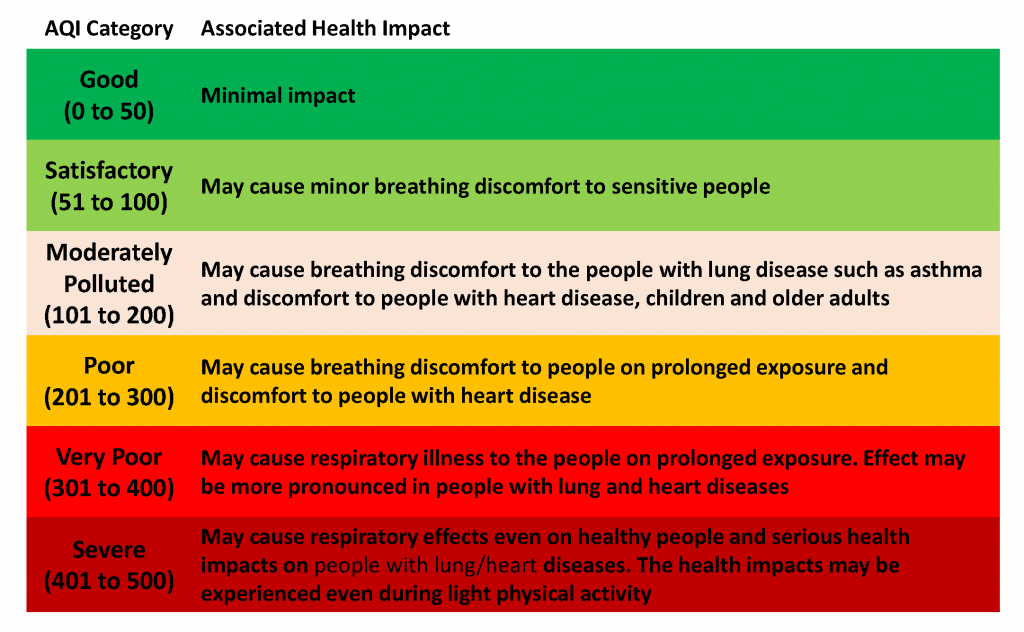Context:
The World Health Organisation (WHO) in its first-ever update since 2005 has tightened global air pollution standards in a recognition of the emerging science in the last decade that the impact of air pollution on health is much more serious than earlier envisaged.
Relevance:
GS-III: Environment and Ecology (Environmental Pollution and Degradation, Conservation of the Environment, Important International Institutions and Standards, Government Policies and Initiatives)
Dimensions of the Article:
- About WHO’s Global Air Quality Guidelines (AQGs) 2021
- India’s National Air Quality Index (AQI)
- National Clean Air Programme (NCAP)
- Objectives of NCAP
- Back to the Basics: About WHO
About WHO’s Global Air Quality Guidelines (AQGs) 2021
- WHO’s Global Air Quality Guidelines (AQGs) outlines the recommended air quality levels to protect the health of populations based on the latest scientific evidence from across the world.
- In 2021 WHO announced limits for six pollutant categories —particulate matter (PM) 2.5 and 10, ozone (O3), nitrogen dioxide (NO2) sulphur dioxide (SO2) and carbon monoxide (CO) – and tightened global air pollution standards.
- WHO’s latest move in 2021 tightening norms sets the stage for eventual shifts in policy in the government towards evolving newer stricter standards. I.e., this will soon become part of policy discussions — much like climate targets to reduce greenhouse gas emissions keep getting stricter over time.
- Once cities and States are set targets for meeting pollution emission standards, it could lead to overall changes in national standards.
- The move doesn’t immediately impact India as the National Ambient Air Quality Standards (NAAQS) don’t meet the WHO’s existing standards.

India’s National Air Quality Index (AQI)
- The National Air Quality Index (AQI) was launched in New Delhi in 2014, under the Swachh Bharat Abhiyan.
- The Central Pollution Control Board along with State Pollution Control Boards has been operating National Air Monitoring Program (NAMP) covering 240 cities of the country having more than 342 monitoring stations.
- An Expert Group comprising medical professionals, air quality experts, academia, advocacy groups, and SPCBs was constituted and a technical study was awarded to IIT Kanpur.
- IIT Kanpur and the Expert Group recommended an AQI scheme in 2014.
- The continuous monitoring systems that provide data on near real-time basis are installed in New Delhi, Mumbai, Pune and Ahmedabad.

Understanding the scale
- There are six AQI categories, namely Good, Satisfactory, Moderately polluted, Poor, Very Poor, and Severe.
- The proposed AQI will consider eight pollutants (PM10, PM2.5, NO2, SO2, CO, O3, NH3, and Pb) for which short-term (up to 24-hourly averaging period) National Ambient Air Quality Standards are prescribed.
- Based on the measured ambient concentrations, corresponding standards and likely health impact, a sub-index is calculated for each of these pollutants.
- Likely health impacts for different AQI categories and pollutants have also been suggested, with primary inputs from the medical experts in the group.


National Clean Air Programme (NCAP)
- The Central Government has launched the National Clean Air Programme (NCAP) to reduce particulate matter (PM) pollution.
- NCAP is the first ever effort in the country to frame a national framework for air quality management with a time-bound reduction target.
- India has an overall target to reduce hazardous PM levels by 20-30% by 2024 from their 2017 levels in 122 cities under the NCAP which was launched in 2019.
- NAAQS sets limits for SO₂, NO₂, particulate matter (PM2.5 and PM10), Ozone, Lead, Carbon Monoxide, Ammonia, Benzene, Benzo Pyrene, Arsenic, Nickel.
- Central Pollution Control Board (CPCB) will execute this nation-wide programme in consonance with the section 162 (b) of the Air (Prevention and Control of Pollution) Act, 1986.
- The Ministry of Environment, Forest and Climate Change (MoEFCC), as a nodal central and apex agency, will have to flex its authority to ensure all NCAP indicators are integrated with multi-sector and inter-ministerial programmes to align with the air quality target and objectives.
- The plan includes 102 non-attainment cities, across 23 states and Union territories, which were identified by Central Pollution Control Board (CPCB) on the basis of their ambient air quality data between 2011 and 2015.
- Non-attainment cities are those which have been consistently showing poorer air quality than the National Ambient Air Quality Standards. These include Delhi, Varanasi, Bhopal, Kolkata, Noida, Muzaffarpur, and Mumbai.
- As part of the programme, the Centre also plans to scale up the air quality monitoring network across India.
- Approach of NCAP:
- Collaborative, Multi-scale and Cross-Sectoral Coordination between relevant Central Ministries, State Government and local bodies.
- Focus on no Regret Measures, Participatory and Disciplined approach.
Objectives of NCAP
- To augment and evolve effective and proficient ambient air quality monitoring network across the country for ensuring comprehensive and reliable database
- To have efficient data dissemination and public outreach mechanism for timely measures for prevention and mitigation of air pollution and for inclusive public participation in both planning and implementation of the programmes and policies of government on air pollution
- To have feasible management plan for prevention, control and abatement of air pollution.
Back to the Basics: About WHO
- The World Health Organization (WHO) is a specialized agency of the United Nations responsible for international public health.
- It is headquartered in Geneva, Switzerland.
- Its main objective is ensuring “the attainment by all peoples of the highest possible level of health.”
- The WHO’s broad mandate includes advocating for universal healthcare, monitoring public health risks, coordinating responses to health emergencies, and promoting human health and well-being.
- The World Health Assembly (WHA), composed of representatives from all 194 member states, serves as the agency’s supreme decision-making body.
-Source: The Hindu





